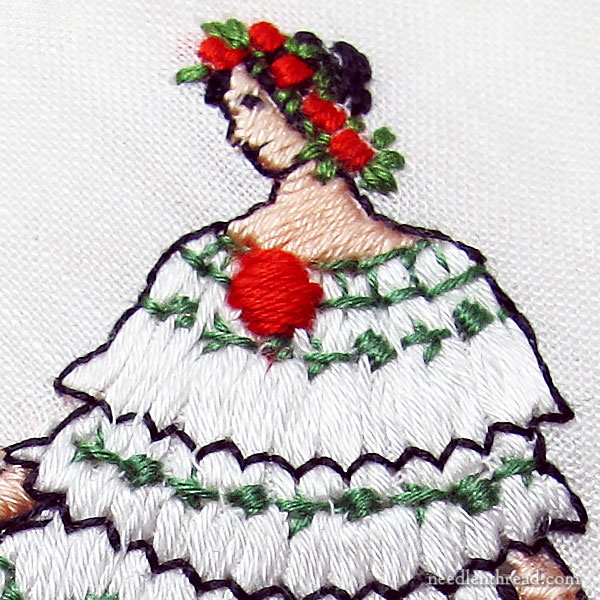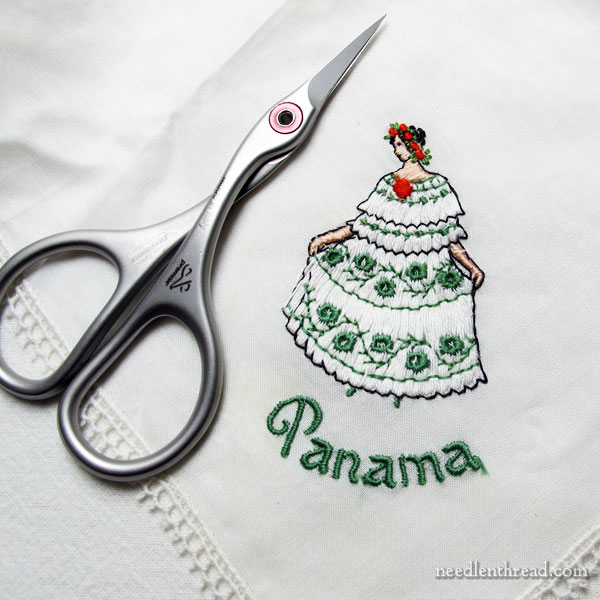Have you ever been charmed by embroidery?
Well, to start your Monday off, here are two pieces of embroidery that have charmed me. I find them delightful!
Both handkerchiefs below are hand embroidered with figures – a dancing lady, children playing. They’re colorful and fun, and they were undoubtedly embroidered for the tourist market.
Just because they are souvenirs, though, don’t write off the embroidery! Sure, at souvenir shops these days, you can still find embroidered hankies – machine embroidered, produced in bulk, lacking quality, and usually pretty devoid of personality.
But these hand embroidered hankies are just lovely, they’re packed with personality, and they can teach us a lot!

Here’s an elegant dancing lady, embroidered in a white gown festooned with green flowers; she has red roses in her hair, and very tiny feet!
The embroidery here is interesting. It’s worked in a soft cotton, like a coton a broder.
The majority of stitching is satin stitch, with a bit of double running stitch and some straight stitching.
The white background of the dress is embroidered in long satin stitches that run down the whole length of the dress, from neck to hem.
All the decoration on the dress – from the flowers to the scallops – serves not only to embellish the dress, but to secure those long satin stitches.

Here it is from the back. What might look like backstitch on the front (the green lines, just below each row of flowers) is actually a double running stitch (or reverse running stitch) – running stitch worked in one direction first, and then returning along the same line, filling in the gaps with another running stitch.
You can see that the threads carry across the motif. There’s a flesh colored thread traveling from arm to arm, run underneath some of the stitching already there.

Here’s a close-up of the flowers on the front of the dress. They’re pretty simple rounds, like eyelets, and while they might not look very accurate close up, their overall effect in that little space is quite balanced.
The vine is backstitched along the main movement, with small straight stitches coming off it.

The face, the hair, the roses, the green leaves – all of these are satin stitch.
The whole piece is outlined in a double running stitch in black, in a slightly finer thread. This was a good move. The double running stitch allows for the look of backstitch on the front – a solid line – but on the back, it avoids the build-up of stem stitch that results from a regular backstitch.

She’s from Panama, by the way!
When I first glanced at the handkerchief – another handkerchief from Jane’s collection, which I’ve written about before – my brain took in “Pamela.” It took it a second to register “Panama,” so I have dubbed her Panama Pamela.
(Try saying that ten times fast!)

She’s pretty tiny, by the way.

And this delightful little hanky hails from Korea. Jumping teeter-totter is a popular game in Korea.
The game or sport is featured here, played by young girls in traditional clothing.

This particular embroidery is worked in a fine cotton floss. The majority of stitching is stem stitch for the outlines, worked at an extreme slant where the outlines are thicker. The hair, bows, and scarf are worked in satin stitch.
I love this piece! It seems like such a strange scene to embroider on a hanky, but given the size of the handkerchief (which is just about 8″ square), I’m thinking it’s a child’s handkerchief.
The ground fabric on this one is linen, by the way. Panama Pamela resides on a cotton ground.
Fun, aren’t they? You don’t often see figures embroidered on handkerchiefs. These two examples have just charm the heck out of me. They make me happy!
More Vintage Embroidered Handkerchiefs
You can find more handkerchiefs from this collection highlighted in the articles listed below:
Vintage Handkerchiefs and Trailing
Hand Embroidery vs. Machine Embroidery and how to tell the difference
A Little Touch of Spring on a Vintage Embroidered Handkerchief







I love those! They are indeed packed with personality.
I love vintage hankies and have may from my childhood. A few that I have crocheted around the edges also. My though is /was to some day make a coverlet for my bed.
Dear Mary
What lovely embroidered hankies especially Pamela from Panama or Panama Pamela she’s adorable I love her dress and the garland of roses on her head lovely. The two young girls jumping teeter-totter (I love the words you think up) in traditional costume are unusual and adorable and I can understand why they make you happy. It’s nice to see embroidered figures on hankies unusual. Thanks for sharing with us these lovely embroidered pieces a nice blog for a Monday afternoon.
Regards Anita Simmance
Hi, Anita –
Mary didn’t make up the word – that’s the game was called in the Midwest and also usage as in “let’s teeter-totter” for example.
Regards,
Helen
Hi Helen
Thanks for letting me know I’ve not heard the saying before. We call it sew-saw here in the UK as in the song “see saw Margery daw Jackie shall have a new master; Jackie shall earn but a penny a day, Because he can’t work any faster”.
Regards Anita Simmance
LOL! I know that one, Anita! We call them see-saws, here, too, in some parts of the country. Out here in the Midwest, teeter-totter is the common name for it, I think. Funny!!
These are great! What is incredible to me, besides the embroidery itself, is the great artwork itself. Trying to embroider on handkerchiefs and draw my own designs, I find getting the scale, balance and theme to all work out well (before even threading the needle!) is tough. I really like the little girls playing because they look so well proportioned. Thanks for sharing these little cuties!
I must say that Pamela is rather lovely. 🙂 I wonder who stitched her. 🙂
Someone should turn Pamela and Kory and Ana (Koreana sisters) into a pattern. They remind me of some stamps I have of all the cultural dresses of the different areas of Spain.
Hi Mary,
Panama Pamela is as cute as can be! I happen to love vintage embroidery and this has now become what I love to stitch -vintage patterns and fabrics.
I have a question: Do you know anything about a past embroidery company from Glasgow, Scotland called “Fairistytch”? I acquired a tablecloth of recent and learned it is a Fairistytch tablecloth. Trying to learn anything about this 1900-1950’s era company has been next to nothing. I’d like to know much more and if they ever made transfers or only sold linen with the transfers pre stamped on linen.
If you (or any readers) could share any information, I’d be so thankful!
On the site you may read about Fairistytch in”Art Needlework and Embroidery Transfers 1870-1970″ By Molly Proctor. At a glance it appears that the company specialized in high quality stamped linens from 1919 to 1960. There are some beautiful illustrations of Fairistytch in the book. According to the author, each stamped linen piece was accompanied by a full color illustration and floss recommendations. Florals were the company specialty.
The site is……..books.google.com. Don’t know why the address disappeared in my previous post. Sorry.
So cute! I really like them; they are adorably charming – I agree!
Love these–especially the Korean girls. What struck me about them is actually how the design is not really centered–as if they had to give the girl on the right a running start to begin her jump. I also love the effect of that steep stem stitch. It almost looks like satin stitch in places.
I have a hankie like yours with the little Korean girls on it and I never knew what they were doing – thank you for solving the mystery!
Thank you for another embroidery “autopsy.” I would have guessed the green floral vines on Panama Pamela were machined because I didn’t understand the double running stitch.
They are so charming! Great pictures, it’s wonderful to be able to see the detail.
Love these! I can’t help my self when we go to antique stores and swap meets from looking for (and buying) vintage hankies. My favorites are usually the hand embroidered ones. Even though the stitching may not be the most precise (they are still beautiful) it still amazes me how tiny the stitches are and usually on sheer and delicate fabrics!
Thank you for sharing these with us.
I’ve been collecting hand embroidered hankies for forty years concentrating mostly on monograms and initials but I have a number with figures. The small hankie with the little girls is one I own and have seen hundreds of times in antique stores, flea markets and yard sales. I have often wondered the story behind it – was it a premium given for magazine sales or possibly a dime store item? I don’t know the answer but would love to learn more about it.
Kris, I’ve speculated about some embroidered pieces, including the Korean girls, suitability as hankies and I wonder if they might have been cocktail napkins. I didn’t know that the Korean girls were so abundant. I assumed a connection with the Korean War/occupation as souvenirs. (When I was in primary school I and my classmates were envious of the teenagers who had satin jackets with brilliantly embroidered dragons or maps of Korea sent by brothers serving overseas.)
Thank you “Green Heron” for your information re: the “Fairistytch” company. I would so love to get some vintage stamped linens created by this company – now out of business. Thanks for writing and caring about my search. I’m most grateful to you.
Roxanne
You are welcome, Roxanne. I am grateful to you for introducing me to needlework of which I was unaware. The Fairistytch designs are lovely.
Thank you Mary for your post about these hankies. It inspired me to finally poke around the web for more information about the Korean girls hankies and I had great success! This site: http://theliteratequilter.blogspot.com/2014/03/operation-hanky-uncommon-story-behind.html has the full story about this hankie. When you read it you will understand why we see this little hankie so frequently. I love learning stuff like this. 😎
Oh, thanks, Kris!! Very interesting story – will have to direct readers to it!
Here is the story behind the girls on the second embroidered hanky!
http://theliteratequilter.blogspot.com/2014/03/operation-hanky-uncommon-story-behind.html
Hi,Nancy – yes, I just wrote about that today, and included her blog post link and another, more detailed article. Fascinating!
Long ago Korean women were not permitted outside the house and walled yards. Teeter totter became a popular sport since it allowed these women and girls a chance to peak over the walls to see the wider world while they were jumping.